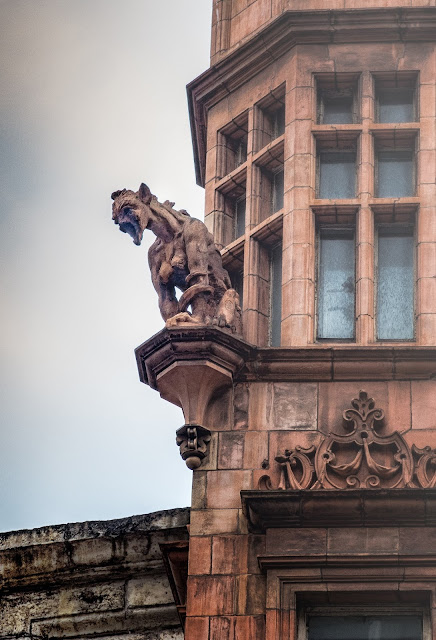The Priory of The Holy Trinity was founded on the eastern
edge of the City of London in 1108 by Matilda, Henry I's consort. By her
generous endowment she gave not only the vast priory church and convent, but
also the whole ward of Portsoken, four parishes (including that of St
Katharine) and the City gate (Aldgate). By repute, the institution, with its
widely extended buildings, was magnificent (the present Mitre Square lies above
the priory cloisters, while a section of arches from the interior of the priory church survives in the reception area of an office building on the north side of Leadenhall Street).
The parishioners of St Katharine's first met for divine
service at the altar of St Mary Magdalen in the south part of the priory church, but this was inconvenient because of the distraction from the reciting
of the offices in the main body of the building. So it was that eventually, by agreement with the Priory, the
church of St Katharine was built at the south-west corner of the Priory's land at the instance of Lord Richard de Graveshende, Bishop of
London. This first church was built between 1280 and 1303.
The first church was, at the outset, served by one of the
Canons of the Priory; in addition, the parishioners were obliged to resort to
the Priory church at certain times of the church year. However "contention
and discord" existed between the Prior and parishioners until 1414 when,
by order of Bishop Clifford at his visitation, the church became again a parish
church or chapel with the privileges appertaining to it and this was confirmed
by Bishop Fitzjames on March 17 1568.
Little is known of the style of this first parish church. Plans made
by A.J. Symans in 1592 (61 years after the Priory was dissolved by Henry VIII
and given to Lord Audley) led Sir Walter Besant to comment that from the
frequency of the window openings on the second floor plan "It would appear
to have been in the Perpendicular style". Ancient masonry can still be
traced, just above ground level, along the south and west fronts, that is in Leadenhall
Street and Creechurch Lane. However it is known that the tower was built in 1504, with money
left by Sir John Percivall, Merchant Taylor. The lower part of Percivall's
tower is incorporated into the present structure, as is evident from the
Perpendicular Gothic window at the first stage.
The church became known as St Katharine Christchurch,
because of its connection with the Priory church, which had been named
"Christ's Church" by Matilda (the Priory was commonly known as "Christchurch Priory"). Later this became varied to "St Katharine
Creechurch" or, as now, "St Katharine Cree". The
change is more readily understood if one remembers that "Christ" was
once pronounced "Chreest".
In I531 the Priory was dissolved and its buildings given to Henry Lord Audley. He, in turn, offered the Priory Church to the parishioners of St
Katharine but, for reasons that are no longer clear, they refused the offer. However,
by 1620 St Katharine Creechurch was in serious disrepair—a deed dated 15 September 1629
refers to the "ruin and decay" of the church, causing structures to
fall and so the building was pulled down.
By this time, the level of the high street had been, as John
Stow (1598) says: "So often raised by pavements that now men are faine to
descende into the…church by divers steps, seven in number". The current
building is, therefore, much above the floor level of the first church. On the
south side, just inside the building, can be seen the top of one of the pillars
of the old church, now at waist height—an effective illustration of the change
in floor level.
The new church was built between 1628 and 1630/1 under the
influence of William Laud, at that time Bishop of London, and it was consecrated by
him on 16 January 1630/1, as recorded in his diary. The ceremonial used by Laud
at the consecration was later turned into a weapon to use against him at his
trial and he was beheaded in 1645.
The church is one of very few left untouched by the Great
Fire of London in 1666. It now stands in need of significant internal and
external restoration and of friends and supporters for this task. They are
beginning to appear.
 |
St Katharine Cree, looking east.
The architectural style is a fusion of late Perpendicular Gothic and neo-Clasical styles, architecturally unique in London and rare nationally. The great rose window is 17th-century glass. On the ceiling are the coats of arms of the City and of some of the livery companies of the City, including the "Great Twelve" most ancient and wealthiest ones |
 |
St Katharine Cree, looking west.
The great organ, restored in 2003, is substantially an extremely good Victorian instrument, but retains some pipes from the original 17th-century instrument that was played by both Henry Purcell and John Blow. |




























